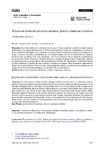Rituales de distinción del artista moderno: flânerie, dandismo y bohemia

Use este enlace para citar
http://hdl.handle.net/2183/31609Coleccións
- Investigacion (ETSAC) [512]
Metadatos
Mostrar o rexistro completo do ítemTítulo
Rituales de distinción del artista moderno: flânerie, dandismo y bohemiaTítulo(s) alternativo(s)
Rituals of distinction of the modern artist: flânerie, dandyism and bohèmeAutor(es)
Data
2022Cita bibliográfica
Pérez-Sánchez,Y. (2022). Rituales de distinción del artista moderno: flânerie, dandismo y bohemia. Arte, Individuo y Sociedad 34 (3), 1051-1067, https://dx.doi.org/10.5209/aris.76590
Resumo
[Resumen]
Este texto analiza tres actitudes con las que el artista moderno, a modo de ritual, expresó
públicamente sus signos de distinción en el París decimonónico: la flânerie, el dandismo y la bohemia.
Estas actitudes lo distinguen en el escenario de una metrópoli tomada por las masas y la burguesía en
la que el artista se identifica, principalmente, con el flâneur, figura clave de la modernidad que inaugura
un nuevo tipo de mirada sobre una ciudad que, a su vez, lo observa. Así lo exponen tempranamente
Georg Simmel, Walter Benjamin o Siegfried Kracauer, además del propio Charles Baudelaire, epítome
del artista moderno y de un modo de vida continuado por célebres del “malditismo” como Paul Verlaine
y Arthur Rimbaud. El análisis de estas actitudes se ilustra con algunas obras litográficas, fundamentalmente de Honoré Daumier y Paul Gavarni, cuya perspectiva aguda y sarcástica revela algunos de los
rasgos claves de la vida metropolitana y de sus tipos más característicos [Abstract]
The text focuses on three attitudes through which the modern artist, in a ritualistic manner,
publicly expressed distinction in nineteenth-century Paris: flânerie, dandyism and bohemianism. These
attitudes distinguish him on the stage of a metropolis taken over by the masses and the bourgeoisie in
which the artist identifies himself, mainly, with the flâneur, a key figure of modernity who creates a new
type of gaze on a city which, in turn, also observed him. So was analyzed by Georg Simmel, Walter
Benjamin, Siegfried Kracauer, as by Charles Baudelaire himself, the epitome of the modern artist and
of a way of life continued by accursed poets such as Paul Verlaine and Arthur Rimbaud. The analysis of
these attitudes is supported by lithographic works, mostly signed by Honoré Daumier and Paul Gavarni,
where some of the key features of metropolitan life and its most characteristic types are revealed from
an acute and sarcastic perspective.
Palabras chave
Artista moderno
Baudelaire
Flâneur
Dandismo
Bohemia
Modern artist
Dandyism
Bohème
Baudelaire
Flâneur
Dandismo
Bohemia
Modern artist
Dandyism
Bohème
Versión do editor
Dereitos
Atribución 3.0 España
ISSN
1131-5598






